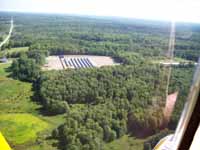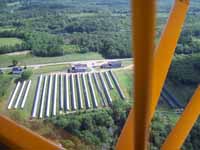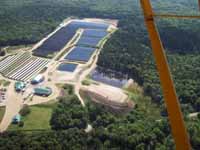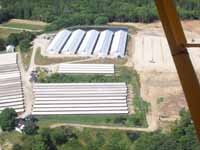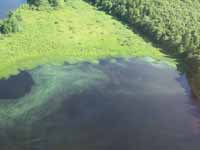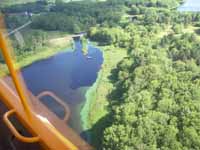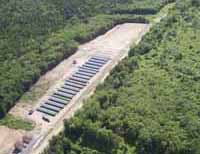Some of the Mink Farms on the Tusket
from John Horton July 1st 2011
Click on pictures for enlargement
The Impacts of the Mink Industry on Freshwater Lakes in Nova Scotia
An Overview of Concerns
The Value of Freshwater Lakes and Rivers
Water is unquestionably one of the most
important natural
resources on Earth –everyone and everything needs water to live (EAC).
Currently
greater than one billion people lack access to safe drinking water.
Freshwater is a particularly precious resource, making up only 2.5% of the world’s water with the remaining 97.5% found in saltwater oceans and seas. In Canada we have long considered freshwater to be an almost unlimited resource and yet only 7% of the world's renewable fresh water is found in this country (Environment Canada. http://www.ec.gc.ca/eau-water/default.asp?lang=En&n=11A8CA33-1)
Nova Scotia is lake rich but only 5 percent of Nova Scotia is covered by fresh water (NSM 1996 at 157).[1] Some of Nova Scotia’s largest freshwater resources can be found in the lakes and river systems of south western Nova Scotia.
The Wentworth, Carleton, Meteghan, Sissiboo and Tusket Rivers all run through this area draining enormous watersheds in the municipalities of Clare, Digby, Yarmouth and Argyle.
The Tusket River, by length and volume, is the largest of southwestern (SW) Nova Scotia’s network of rivers with its headwaters 70 km inland. The watershed drains approximately 2,000 km2, or about 50% of the land area of Yarmouth County and 20% of Digby County (Smith 2004 at 247). .[2]
The Carleton River, occasionally referred to as the West Branch of the Tusket, is one of the Tusket’s largest tributaries, draining about 17% of the Tusket’s watershed, or about 335 km2 (Smith 2004 at 267).
Threatened Lakes and Ecosystems
Unfortunately the lakes and rivers in parts of SW Nova Scotia are under serious threat. Residents who live along these rivers and lakes have been ringing alarm bells over the deterioration for many years. Several of the lakes have artificially eutrophied as a result of nutrient inputs from human activities and some have developed blue green algae (cyanobacteria) blooms.[3]
In 2009 Nova Scotia Environment released a report which included the results of 2008 water quality testing on nine lakes in the Carleton River Watershed area. Three lakes, Nowlans, Placides and Hourglass were found to be eutrophic. Five lakes, Provost, Porcupine, Parr, Ogden and Fanning were found to be mesotrophic. One lake, Vaughan, was oligotrophic (Taylor 2009).
In 2010 Nova Scotia Environment released a report which included the results of repeat water quality testing (completed in 2009)on the lakes in the original study and one additional lake (Sloan’s Lake) plus some tributaries. In that report, three lakes Nowlans, Placides and Hourglass were found to be hyper-eutrophic to eutrophic. Three lakes, Parr, Odgen and Fanning were found to be eutrophic to mesotrophic. Three lakes, Provost, Porcupine and Vaughan were found to be mesotrophic. One lake, Sloans, was oligotrophic (Taylor 2010).[4]
This study confirms a significant overall increasing nutrient trend in area lakes since the mid 1980s and deteriorating water quality. Human related nutrient sources are likely contributing significantly to lake nutrient levels in certain watersheds and impacting lake water quality (Taylor 2010 at 9).
Eight of the lakes studied are located in the Carleton River Watershed. The Carleton River drains approximately 200 km2 of watershed and contains close to 100 lakes. As mentioned above, the Carleton River is one of the primary tributaries of the Tusket River. Nowlans Lake is headwater of the Meteghan River system. Provost Lake is a headwater lake in the Sissiboo River system.
Total Phosphorus concentrations in most uncontaminated freshwaters are between 10 µg.L-1 and 50 µg.L-1 (Environment Canada 2004 at 11). Seven of the ten lakes sampled by Nova Scotia Environment and reported on in 2010 were above 50 µg.L-1.
Two lakes (Placides and Nowlans) had extremely high Total Phosphorus levels, 720 ug/l and 380 ug/l respectively. These were comparable to levels found in 2008. Nowlans lake was also observed to be turbid green during the 2009 sampling period, similarly to 2008 (Taylor 2010 at 6).
The two lakes (Placides and Nowlans) with the highest Total Phosphorus levels are headwater lakes, suggesting significant nutrient sources in their immediate watersheds (Taylor 2010).
Typically, headwater lakes are lower in nutrients and productivity than lakes lower in the same watershed, when only natural nutrient sources and processes are at play (Taylor 2010 at 6)
The NSE 2010 study included calculations to estimate the Total Phosphorus concentration of stream water being delivered to a lake by an input stream. The highest Total Phosphorus per day in a tributary stream was 223.86 kg found in a stream draining into Placides Lake (Taylor 2010 at 12).
The elevated phosphorus loading that has and continues to occur in all of these lakes will have adverse effects on the aquatic ecosystems. The increased growth of algae and aquatic macrophytes will ultimately create oxygen deficit and likely result in fish kills. Blooms of cyanobacteria, which have already occurred in Lake Fanning, Lake Ogden and others, contribute to a wide range of problems including summer fish kills, foul odours, tainted drinking water and release of toxins that can kill livestock and may pose a serious health risk to humans (Environment Canada 2004 at xi, also see 35).
Remediation of watersheds which have been cumulatively impacted for years by nutrient pollution can be extremely difficult from a technological and cost perspective, due to changes in water chemistry and internal loading of phosphorus from anoxic sediments brought about by the eutrophication process (NAS 2005).
Health Impacts of Cyanobacteria
Cyanobacteria generally grow in warm, calm waters that contain elevated levels of nutrients (nitrogen and phosphorus). The algal bloom that occurs may appear as suspended little green clumps throughout the water table or a confluent mass on top of the water (NSE 2007, see also Health Canada).
There are a number of possible toxins that may exist in cyanobacteria including microcystins, cylindrospermopsins, anatoxins and saxitoxins. All of these have the potential to be harmful to humans, wild mammals, livestock, birds, dogs etc. Human exposure can occur through skin contact, inhalation and ingestion: health effects can vary from mild to severe (skin irritation, eye irritation, headache, diarrhea, abdominal pain, nausea & vomiting, fever, respiratory symptoms, neurological disease, liver disease, death, etc), depending on the particular toxin exposure and susceptibility of the individual (Health Canada).
Research is ongoing in the scientific community regarding health risk and cyanobacteria toxins, as there is a growing concern about the apparent increasing incidence of blue green algae blooms and health effects related to both chronic and acute toxin exposures (WHO 1999).
Management of Phosphorus in Freshwater Lakes
Given its role in establishing cyanobacteria and the potential for significant environmental harm, phosphorus is on the CCME list of priority pollutants.[5] In 2004 the federal government developed the Canadian Guidance Framework for the Management of Phosphorus in Freshwater Systems.[6] The Guidance Framework lays out phosphorus trigger ranges for Canadian lakes and rivers.
Total phosphorus trigger ranges for Canadian lakes and rivers (Environment Canada 2004 at 2)
|
Trophic Status |
Canadian Trigger Ranges Total phosphorus (µg.L-1 ) |
|
Ulta-oligotrophic |
<4 |
|
Oligotrophic |
4-10 |
|
Mesotrophic |
10-20 |
|
Meso-eutrophic |
20-35 |
|
Eutrophic |
35-100 |
|
Hyper-eutrophic |
>100 |
Once a baseline reference condition has been established for a lake the trigger ranges can be used to determine what steps should be taken to further assess the lake and address the problem. Any lake that is greater than the upper limit of its trigger range or 50% higher than its baseline requires further assessment according to the Guidance Framework (Environment Canada 2004 at 5).
In the case of the ten lakes reported on by NSE in 2010 all, with the exception of Sloans Lake, require further assessment in accordance with the Guidance Framework. Assessment tools recommended by the Guidance Framework include (1) development of a water quality index; (2) multivariate methods and; (3) predictive models such as the Lakeshore Capacity model. To date none of these assessment tools have been implemented in SW Nova Scotia.
The Sources of Phosphorus
In a rural environment nutrient sources from agriculture are the most universally important source of phosphorus (Environment Canada 2004 at 9).
Nutrients are lost from farmland in three ways:
i. By direct surface runoff of fertilizers and manure;
ii. Through leaching of soluble plant nutrients by drainage water percolating through the soils; and
iii. By the erosion of surface soils or by the movement of fine soil particles into subsoil drainage systems (Environment Canada 2004 at 9).
The Mink Industry in Southwestern Nova Scotia
There are approximately 40 mink operations and 1.4 million mink located near the headwater of the Carleton River. The industry has grown by approximately 415% since 1997. The Nova Scotia mink industry has seen a steady climb in profit in recent years with export sales exceeding $65 million in 2008 and about $80 million in 2009.[7]
Assuming a very conservative estimate that 70% of industry growth occurred in the Wentworth-Carleton River watershed, approximately 18200 tonnes of manure will be produced annually by the mink. This will include 455 tonnes of phosphorus and 910 tonnes of nitrogen from the manure as well as 16,380,000 liters of urine annually that can potentially affect surface and ground water in the watershed area. This does not take into account any phosphorus or nitrogen produced from waste feed or chemical agents used in the farming process. It should also be noted that it is impossible to quantify the proportion of urine that is immediately absorbed in the soil.
Relative to their land base, both Yarmouth and Digby Counties have significant animal agriculture, creating manure management challenges (NSFA 2009 at 7). The mink sector, in particular, is primarily located in an area with a small cropland base, reducing alternatives to effectively manage mink manure and other wastes close to mink farms. Transporting excess manure to areas with manure deficits is very expensive and the manure often has to have water removed to reduce its volume for trucking. This expense limits opportunities to manage excess manure based on transporting it to other areas (NSFA 2009 at 21).
Local mink operations are either of traditional or enclosed variety.
The traditional operation means an open air arrangement of wire mink pens in which the mink manure and surplus feed is allowed to drop to the ground, with the pen assembly being covered by a simple pitched roof, without side walls (Pendragon 2008 at 4).
The enclosed operation means an arrangement of mink pens enclosed in a building, structure or enclosure having a roof and walls and in which the manure and surplus feed is stored in a holding tank or other containment approved in a manure management plan approved by the Province of Nova Scotia (Pendragon 2008 at 4).
In December 2009 the Nova Scotia Department of Agriculture completed the Wentworth River System Farm Assessment, reporting on 38 mink operations in the Carleton-Wentworth River Watershed.
37 of the 38 farms reported that runoff from the farm flows into the woods, swamp, marshy area or wet pasture.
“Runoff flows into a 10 acre wet pasture that borders a stream”
“Runoff flows through the woods approximately 30 feet from the lake”
“Runoff flows into woods it is approximately 200 yards to the neighboring lake”
“Runoff flows through the woods and into a natural wetland which flows into Porcupine Lake”
All of these practices were deemed acceptable by the Nova Scotia Department of Agriculture.
Most of the farms reported that manure is stockpiled and spread in the local area even though the NSFA recognized in their 2009 environmental performance report card that the mink sector does not have an adequate cropland base to effectively manage manure (NSFA 2009 at 7).
Regulation of the Mink Industry in Nova Scotia
To operate a commercial fur farm in Nova Scotia one must obtain a Fur Farming Licence under the Agriculture and Marketing Act. To be eligible for this licence new applicants must have 100% of their animals tested by the DOA for Aleutian Disease. The licence application does not require any information on siting of the operation, the management of waste (manure, urine, carcass) or any other potential environmental affects of the operation.
All Nova Scotians are subject to the Nova Scotia Environment Act which prohibits the release of any substance into the environment that may cause an adverse effect (NSEA, section 67). However, a Freedom of Information and Protection of Privacy Act (FOIPOP) request in 2009 revealed no documented enforcement actions issued against mink farm operators under the Nova Scotia Environment Act between 2006 and 2009. During that same period of time there were a minimum of 10 citizen complaints relating to surface or groundwater contamination connected to a mink farm operation.
Recent Changes
In 2010, as public pressure mounted and the rapid deterioration of the lakes became more evident Nova Scotia Environment undertook inspections of approximately 35 mink operations and issued directives to at least five operations. A FOIPOP request has been submitted to obtain information on the nature of the directives, specific numbers and whether the operators have complied with the directives.
Also as a result of public pressure the provincial Department of Agriculture has taken some steps toward the future regulation of the fur industry by passing the Fur Industry Act in 2010. The Act provides a framework but cannot be enforced until regulations, standards and guidelines are developed.
Why be Concerned?
The ecological and human health impacts resulting from the phosphorus loading in the watersheds are the primary reasons for concern. The provincial government has been taking steps to address some concerns through water quality studies, property inspections and development of regulations; however the engagement of the public in this process has been minimal and community members continue to be very concerned about the approach undertaken to address these serious issues.
Some examples include:
- The Department of Agriculture has made it clear that the regulations will not consider the cumulative effects of multiple mink operations in one watershed.
- The Department of Agriculture, the primary promoter of the fur industry is also the primary regulator.
- The Fur Industry Act was passed following several years of input by the fur industry but virtually no input from other members of the public.
The issues associated with the fur industry are not simply agricultural issues, they are environmental issues that require strict enforcement and public oversight. To save the lakes in SW Nova Scotia it is critical that there be meaningful input by concerned citizens and environmental experts in the development of regulations and standards for the fur industry. The positive steps that have been taken by the government to date occurred only because local community members and concerned citizens spoke out.
REFERENCES
Brylinsky, M. 2004. User’s Manual for Prediction of Phosphorus Concentration
In Nova Scotia Lakes: A Tool for Decision Making. Prepared for The Nova Scotia Water Quality Objectives and Model Development Steering Committee--Nova Scotia Department of Environment and Labour.
CCME (Canadian Council of Ministers of the Environment), Water Quality Task Group. 2006. Development of Ecoregion Based Phosphorus Guidelines For Canada: Ontario as a Case Study.
Environment Canada. 2004. Ecosystem Health, Science-Based Solutions, Canadian Guidance Framework for the Management of Phosphorus in Freshwater Systems, Report No.1-8.
Health Canada. Environmental and Workplace Health. Water Talk. Blue-Green Algae (Cyanobacteria) and their Toxins. http://www.hc-sc.gc.ca/ewh-semt/pubs/water-eau/cyanobacter-eng.php
NAS (National Academy of Sciences). 2005. Eutrophication of aquatic ecosystems: Bistability and soil phosphorus. http://www.ncbi.nlm.nih.gov/pmc/articles/PMC1177388/
NSE (Nova Scotia Environment). 2007. Blue-Green Algae. https://www.gov.ns.ca/nse/water/docs/BlueGreenAlgae.pdf
NSFA (Nova Scotia Federation of Agriculture). 2009. Environmental Performance of the Agricultural Sector in Nova Scotia 2009, a report card. Prepared by novaknowledge.
NSM (Nova Scotia Museum). 1996. The Natural History of Nova Scotia, Volume Two, Theme Regions. Nimbus.
Pendragon Consulting. 2008. The Municipality of Digby Residential Livestock Areas
Land Use By-law.
Smith, Andrew L. 2004. Paddling the TOBEATIC, Canoe Routes of Southwestern Nova Scotia. Nimbus Publishing Ltd.
Taylor, Darrell. March 2009. Water & Wastewater Branch, NSE (Nova Scotia Environment). A Water Quality Survey of Ten Lakes in the Carleton River Watershed Area Yarmouth County, Nova Scotia.
Taylor, Darrell. October 2010. Water & Wastewater Branch , NSE (Nova Scotia Environment). A Water Quality Survey of Ten Lakes in the Carleton River Watershed Area Yarmouth and Digby Counties, Nova Scotia.
WHO (World Health Organization). 1999. Toxic Cyanobacteria in Water: A guide to their public health consequences, monitoring and management, Edited by Ingrid Chorus and Jamie Bartram, SIBN 0-419-23930-8. http://www.who.int/water_sanitation_health/resourcesquality/toxcyanchap1.pdf
[1] Of the 2408 km2 of lakes, rivers and wetlands in Nova Scotia an abundance are located in southwestern Nova Scotia.
[2] The government of Nova Scotia has protected a nature reserve along the Tusket River to provide habitat for the establishment and persistence of many coastal plain elements including 6 rare taxa. Nova Scotia Environment. Protected Areas. http://www.gov.ns.ca/nse/protectedareas/nr_tusketriver.asp
[3] Eutrophication is a natural process that occurs in an aging lake or pond as that body of water gradually builds up its concentration of plant nutrients. Natural eutrophication is usually a fairly slow and gradual process, occurring over a period of many centuries. Cultural or artificial eutrophication occurs when human activity introduces increased amounts of these nutrients (i.e. phosphates), which speed up plant growth. The bacterial decomposition of the plant overgrowth and cyanobacteria blooms uses up the oxygen in the water leading to 'dead zones' of depleted oxygen in water bodies, eventually choking the lake of all of its animal life. Also, in the process of decomposition phosphorus is re released back into the water contributing in part to recycling of the nutrients within that body of water. http://www.scienceclarified.com/El-Ex/Eutrophication.html
[4] Water quality sampling was repeated during the Fall of 2010 under the direction of Nova Scotia Environment. The results and analysis of the sampling program have not been made available to the public.
[5] CCME is the Canadian Council of Ministers of the Environment. http://www.ccme.ca/sourcetotap/phosphorus.htm
[6] There is no Canadian Water Quality Guideline for phosphorus because it is not directly toxic to human or aquatic species at levels and forms in the environment. It is the secondary effects of phosphorus loading, such as artificial eutrophication, that may be lethal to aquatic species and harmful to humans (Environment Canada 2004 at 1-8).
